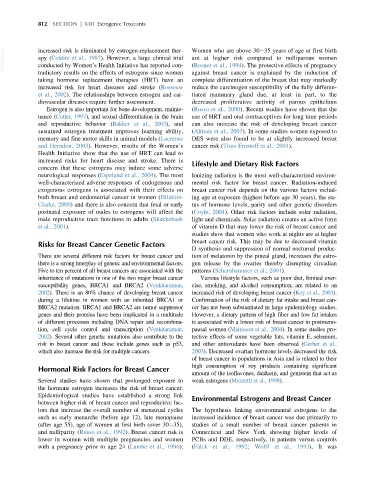Page 854 - Veterinary Toxicology, Basic and Clinical Principles, 3rd Edition
P. 854
812 SECTION | XIII Estrogenic Toxicants
VetBooks.ir increased risk is eliminated by estrogen-replacement ther- Women who are above 30 35 years of age at first birth
are at higher risk compared to nulliparous women
apy (Colditz et al., 1987). However, a large clinical trial
(Rosner et al., 1994). The protective effects of pregnancy
conducted by Women’s Health Initiative has reported con-
tradictory results on the effects of estrogens since women against breast cancer is explained by the induction of
taking hormone replacement therapies (HRT) have an complete differentiation of the breast that may markedly
increased risk for heart diseases and stroke (Rossouw reduce the carcinogen susceptibility of the fully differen-
et al., 2002). The relationships between estrogen and car- tiated mammary gland due, at least in part, to the
diovascular diseases require further assessment. decreased proliferative activity of parous epithelium
Estrogen is also important for bone development, mainte- (Russo et al., 2000). Recent studies have shown that the
nance (Cutler, 1997), and sexual differentiation in the brain use of HRT and oral contraceptives for long time periods
and reproductive behavior (Bakker et al., 2003), and can also increase the risk of developing breast cancer
sustained estrogen treatment improves learning ability, (Althuis et al., 2003). In some studies women exposed to
memory and fine motor skills in animal models (Lacreuse DES were also found to be at slightly increased breast
and Herndon, 2003). However, results of the Women’s cancer risk (Titus-Ernstoff et al., 2001).
Health Initiative show that the use of HRT can lead to
increased risks for heart disease and stroke. There is Lifestyle and Dietary Risk Factors
concern that these estrogens may induce some adverse
neurological responses (Espeland et al., 2004). The most Ionizing radiation is the most well-characterized environ-
well-characterized adverse responses of endogenous and mental risk factor for breast cancer. Radiation-induced
exogenous estrogens is associated with their effects on breast cancer risk depends on the various factors includ-
both breast and endometrial cancer in women (Hilakivi- ing age at exposure (highest before age 30 years), the sta-
Clarke, 2000) and there is also concern that fetal or early tus of hormone levels, parity and other genetic disorders
postnatal exposure of males to estrogens will affect the (Coyle, 2004). Other risk factors include solar radiation,
male reproductive tract functions in adults (Skakkebaek light and chemicals. Solar radiation creates an active form
et al., 2001). of vitamin D that may lower the risk of breast cancer and
studies show that women who work at nights are at higher
breast cancer risk. This may be due to decreased vitamin
Risks for Breast Cancer Genetic Factors
D synthesis and suppression of normal nocturnal produc-
There are several different risk factors for breast cancer and tion of melatonin by the pineal gland, increases the estro-
there is a strong interplay of genetic and environmental factors. gen release by the ovaries thereby disrupting circadian
Five to ten percent of all breast cancers are associated with the patterns (Schernhammer et al., 2001).
inheritance of mutations in one of the two major breast cancer Various lifestyle factors, such as poor diet, limited exer-
susceptibility genes, BRCA1 and BRCA2 (Venkitaraman, cise, smoking, and alcohol consumption, are related to an
2002). There is an 80% chance of developing breast cancer increased risk of developing breast cancer (Key et al., 2003).
during a lifetime in women with an inherited BRCA1 or Confirmation of the risk of dietary fat intake and breast can-
BRCA2 mutation. BRCA1 and BRCA2 are tumor suppressor cer has not been substantiated in large epidemiology studies.
genes and their proteins have been implicated in a multitude However, a dietary pattern of high fiber and low fat intakes
of different processes including DNA repair and recombina- is associated with a lower risk of breast cancer in postmeno-
tion, cell cycle control and transcription (Venkitaraman, pausal women (Mattisson et al., 2004). In some studies pro-
2002). Several other genetic mutations also contribute to the tective effects of some vegetable fats, vitamin E, selenium,
risk in breast cancer and these include genes such as p53, and other antioxidants have been observed (Gerber et al.,
which also increase the risk for multiple cancers. 2003). Decreased ovarian hormone levels decreased the risk
of breast cancer in populations in Asia and is related to their
high consumption of soy products containing significant
Hormonal Risk Factors for Breast Cancer
amount of the isoflavones, daidzein, and genistein that act as
Several studies have shown that prolonged exposure to weak estrogens (Mezzetti et al., 1998).
the hormone estrogen increases the risk of breast cancer.
Epidemiological studies have established a strong link Environmental Estrogens and Breast Cancer
between higher risk of breast cancer and reproductive fac-
tors that increase the overall number of menstrual cycles The hypothesis linking environmental estrogens to the
such as early menarche (before age 12), late menopause increased incidence of breast cancer was due primarily to
(after age 55), age of women at first birth (over 30 35), studies of a small number of breast cancer patients in
and nulliparity (Russo et al., 1992). Breast cancer risk is Connecticut and New York showing higher levels of
lower in women with multiple pregnancies and women PCBs and DDE, respectively, in patients versus controls
with a pregnancy prior to age 24 (Lambe et al., 1996). (Falck et al., 1992; Wolff et al., 1993). It was

